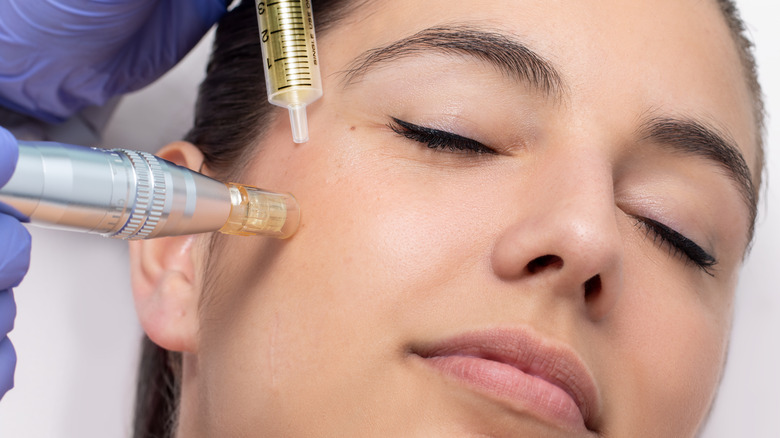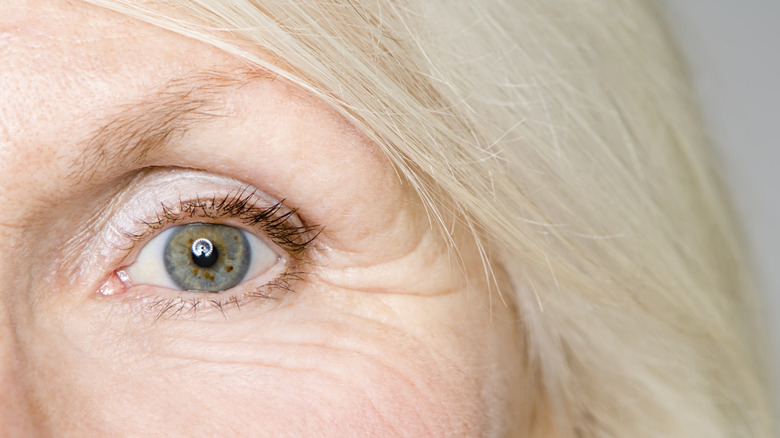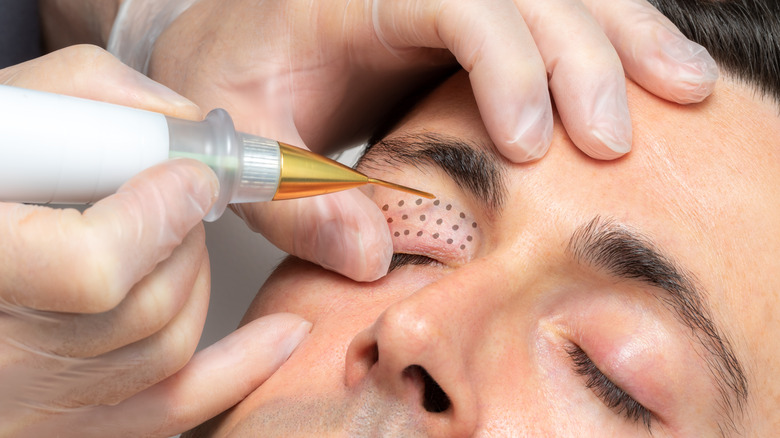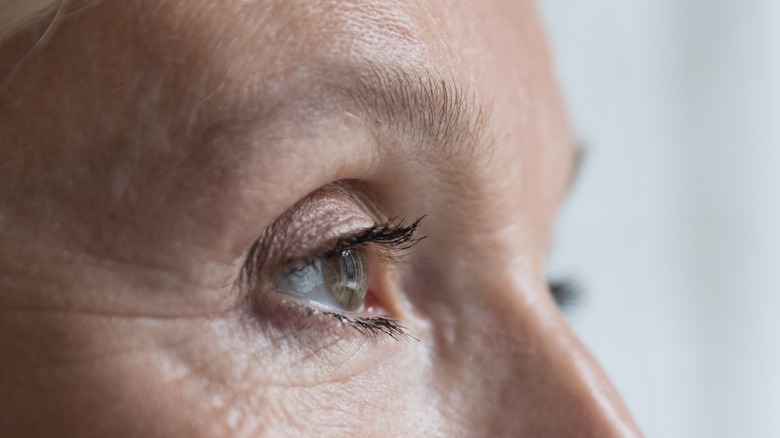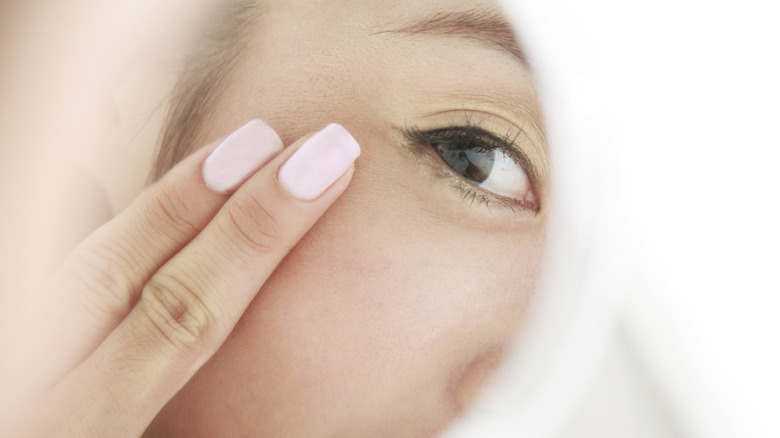Plasma Pen Treatments: The Latest Procedure To Cram More Collagen In Your Under-Eyes
The skin around the eye area is quite delicate due to a lack of fat, which is why the under-eyes are usually the first spots to show enervation and aging signs. As you age, your body produces less collagen to moisturize and plump the skin, causing your under-eye skin to sag and the creases around it to become more pronounced. To give your eyes a plumper and fresher appearance, you need to feed it a steady diet of collagen to replenish this vital protein in deficient areas. And for that to happen, you need to find a way to boost the proliferation of fibroblasts, the cell type responsible for producing collagen in the dermis. The plasma pen — the last word in fibroblast therapy — is the perfect treatment for that.
If you're looking for a non-invasive way to combat the crow's feet and bags around your eyes long-term, plasma pen treatments will not disappoint. Compared to plastic surgery, this cutting-edge technology requires minimal downtime and comes with less side effects. A potent fibroblast blaster and a collagen booster, the plasma pen treatment is one of the most sought-after regenerative therapies for cosmetic eye issues these days. Here's everything to know about the plasma pen treatment, the latest cosmetic procedure that promises surgical-like results.
The plasma pen and how it works
According to Beauti Science Med Spa, the plasma pen is a fibroblast therapy used to stimulate the synthesis of collagen in the skin through the use of an FDA-approved needled device with the power of an electrically-charged gas known as plasma. The plasma pen works by delivering the plasma energy into the skin.
When used, the device emits a low-voltage electrical charge and converts it into gaseous diatomic molecular nitrogen, which is then transmitted into the skin's surface without actually coming into contact with it. This plasma flash created during the process blasts heat into the skin and inflicts controlled trauma to the fibroblast cells in the dermal layers, triggering them to produce more skin-friendly proteins such as collagen, elastin, and hyaluronic acid. In simpler terms, the plasma pen burns the top layer of the skin to tighten it and give it a firmer feel. "The goal of the procedure is to create shallow and narrow zones of ablation in the epidermis, or upper layer of skin, to produce small areas of contraction," explains dermatologist Dr. Sameer Bashey (via RealSelf).
During the healing process, the tiny scabs formed during the treatment will shed and reveal a new layer of skin that looks and feels plumper.
Benefits of plasma pen treatments
The plasma pen treatments can tighten loose skin and brighten it for an even-toned, wrinkle-free complexion. "By promoting the production of collagen and elastin, plasma pen treatments can help to improve skin elasticity, making it appear more youthful and firm," dermatologist Dr. Jason Emer tells Bustle.
According to West End Plastic Surgery, aside from the under-eyes, the plasma pen treatments can be used to curtail wrinkles and rejuvenate the skin on other parts of the face such as the eyelids, eyebrows, the forehead, the temples, the cheeks, the mouth corners, and the jaw. Those suffering from stretch marks on their bellies, wrinkled décolletage, neck folds, skin tags, hemangiomas, blemishes, saggy leg and arm skin, as well as noticeable thread veins can also benefit from the plasma pen treatments. However, the fibroblasting treatments are usually reserved for the treatment of the facial area.
The best thing about the plasma pen is that it's non-invasive and therefore less likely to result in severe complications, which makes it ideal for those who are not yet ready to go under the knife to get rid of aging lines.
Who can benefit from the plasma pen
Although the plasma pen treatments are generally safe and effective, they are not necessarily the best anti-aging solution for everyone out there.
Before going under the pen, consult a professional to know what options you have and to what extent the plasma pen results can align with your expectations. Age-wise, there isn't a set age restriction for the treatment, but You Only Younger notes that it's best suited for people aged 30 and above who have developed aging lines, and the benefits are more noticeable on those with lighter skin. This therapy is not recommended for people who are pregnant or breastfeeding, as well as those with an autoimmune condition or existing sensitive skin condition.
People in their early 20s who want to reduce risks of wrinkled skin can use Botox, which temporarily paralyzes the muscles underneath your skin by blocking facial nerves to prevent the formation of dynamic wrinkles such as horizontal forehead lines and crow's feet. "Younger individuals may not have enough skin laxity to benefit from the treatment, while older individuals may require more extensive procedures," dermatologist Dr. Jason Emer tells Bustle.
What to expect during and after a plasma pen treatment
The plasma pen therapy typically takes place in a clinical setting and you can leave after the treatment. The process usually starts with your practitioner administering a numbing cream to the area that needs treating half an hour before the procedure. During the treatment, your specialist will use a plasma pen to puncture tiny holes in your skin to activate the production of fibroblast cells. The numbing cream is there to mitigate the pain, but you might still expect a minor level of discomfort.
After the treatment, you'll notice carbon crusts and scabs forming at the sites of the wounds, which usually fall off within a week after treatment to expose a new layer of skin. During the recovery process, expect mild swelling, bruising, and itchiness. However, these side effects usually clear within two weeks. According to Collagen Clinique, depending on the condition of the patient's skin and their aftercare practices, the results of the plasma pen can last anywhere between two to five years. The skin-tightening results can be seen immediately once the wounds have been healed, which takes about two to three weeks, but the condition of the treated area will continue improving thanks to a gradual buildup of collagen in the body. Some people may only require one treatment, while others may need more than a follow-up session planned two or three months following the initial treatment, depending on their needs and the progress of their treatments.
Plasma pen aftercare tips
It's important to follow all aftercare instructions to maintain the results of your treatment. If you have the procedure on the eyelid, PlasmaPen™ by Louise Walsh advises against using contact lenses for roughly a week. During the first 48 hours following treatment, you should refrain from touching or wetting the treated area. You should also wait to apply cosmetics to the treated area until your doctor gives the all-clear.
When your wounds are still in the healing process, steer clear of hot tubs, steamy saunas, and physically demanding activities since the heat and perspiration can irritate your skin and cause your scabs to peel before your wounds have a chance to heal. Your practitioner might also advise you to avoid sun exposure whenever possible and when you're outdoors, always wear a broad-spectrum sunscreen and stay in the shade.
Your skin will experience inflammation after the treatment, but it's necessary for the rejuvenating process of your skin. Therefore, refrain from applying a cold compress to your wounds to soothe the swelling or taking anti-inflammatory medications. These attempts can interfere with your skin's healing process and compromise your results. You should only use what your specialist prescribes for you.
Potential downsides and alternative treatments
Like all cosmetic treatments, the plasma pen also has downsides. For instance, this therapy, if gone wrong, can put people at risk of hyperpigmentation and scarring, per RealSelf. Because of higher risks of hyperpigmentation, individuals with brown or olive skin are not prime candidates for the plasma pen treatments. Microneedling, a non-invasive procedure that helps improve the look of wrinkles and scars, is a safer alternative for those with darker skin.
Besides, not all plasma pen therapy service providers use high-quality, FDA-approved pens. You'll have to do your due diligence to make sure your practitioners have sufficient skills and knowledge of the treatment and access to quality, FDA-approved pens, such as the Louise Walsh plasma pens.
Furthermore, the plasma pen treatments might not yield significant improvements in those with severely sagging skin or extensive wrinkle depths, which can only be fixed by plastic surgery. Non-invasive treatments like the plasma pen are better suited for those with mild to moderate skin laxity.
Plasma pen versus Botox
Both the plasma pen and Botox target under-eye wrinkles and bags to restore a more youthful appearance to the face in a minimally invasive way, but they work differently.
For a start, Botox is less skin-traumatic than a plasma pen therapy because it does not break down proteins in the skin to stimulate tissue regeneration like the latter. Botox injections are usually used as part of a "prejuvenation" treatment to keep off aging signs, while a plasma pen treatment can be used to fill in existing wrinkles.
In terms of recovery, Botox requires less downtime and takes only a couple of days to see noticeable results, while a plasma pen treatment requires more post-op care and takes weeks to see results. However, the effects of the plasma pen can last up to three or four years and so require fewer touch-ups than Botox results, which often wear off after three to four months. People with darker skin, who are not the best candidates for plasma pen treatments, can still achieve desirable results with Botox.
Between the plasma pen and Botox, the former costs between $400 and $1,900, while the latter is in the range of $250 to $1,500 on average.
Both the plasma pen and Botox are non-surgical treatments and ideal for those looking to temporarily improve the look and feel of their skin. However, the plasma pen treatments are more suitable for those with more severe skin laxity or those looking for a more long-term solution to their cosmetic issues.
